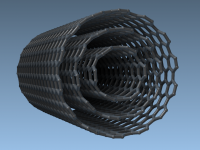Clarify Protein–Ligand Interactions with Interactive 2D Diagrams

For molecular modelers working on protein-ligand complexes, deciphering complex interaction patterns can be challenging, especially when navigating dense 3D environments. Identifying hydrogen bonds, hydrophobic contacts, and clashes visually in 3D often requires substantial effort—and sometimes even multiple tools. The Interaction…
Tired of your molecular view drifting in animations?
A Quick Guide to Building Multi-Walled Carbon Nanotubes in SAMSON

For molecular modelers working with carbon nanostructures, creating accurate models of carbon nanotubes (CNTs) can be a time-consuming task—especially when aiming to simulate or analyze multi-walled configurations. Whether you’re preparing for a simulation, visualizing a nanostructure for publication, or testing…
Easily Orbit Around Molecules for Better Presentations and Insight
Easily Filter and Organize Molecular Models with Node Group Attributes in SAMSON
Avoid Disorienting Zooms in Molecular Animations with One Simple Setting
Why Molecular Modelers Should Care About Versioning
Visualizing Molecular Transformations with a Smooth Fade
Clarifying Complex Motion with the Rotate Animation in SAMSON

When working with molecular models, visualizing movements is often crucial to understanding molecular function. Whether you’re studying conformational changes, ligand docking pathways, or simply presenting your simulation results, clear and intuitive animations can help tell a more compelling story —…










